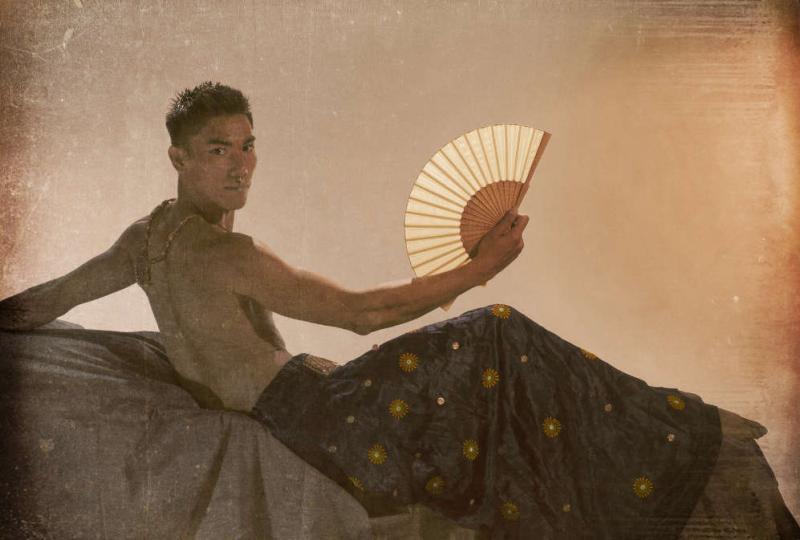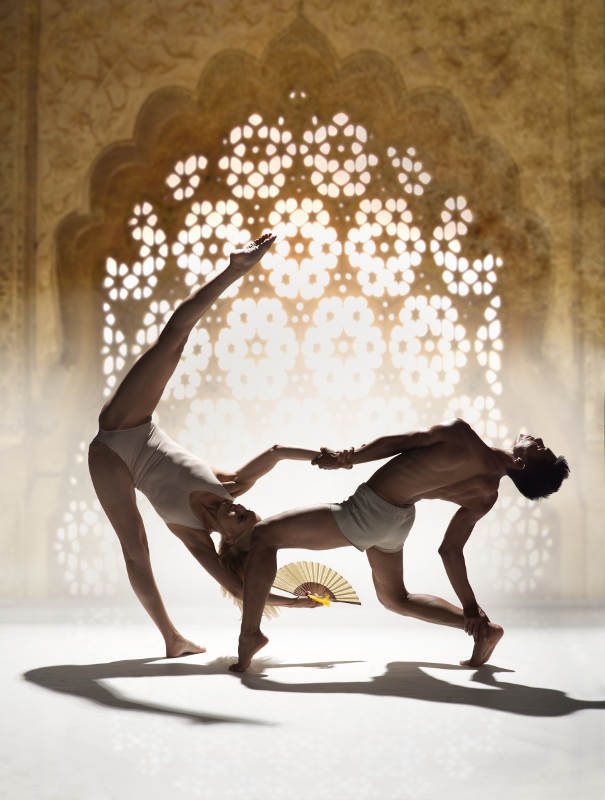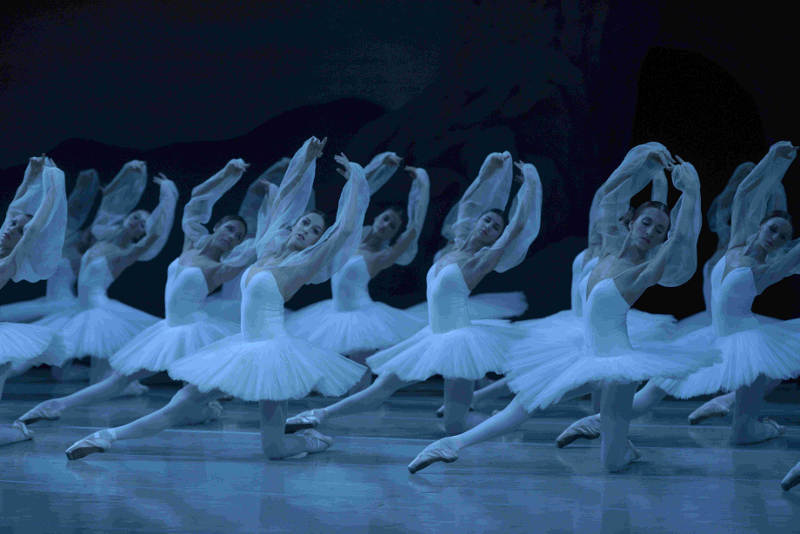Bayadère - The Ninth Life, Shobana Jeyasingh Company, Linbury Studio Theatre | reviews, news & interviews
Bayadère - The Ninth Life, Shobana Jeyasingh Company, Linbury Studio Theatre
Bayadère - The Ninth Life, Shobana Jeyasingh Company, Linbury Studio Theatre
Engaging dance treatment of Indian-European cultural and disciplinary encounters

The premise of last night’s world première made so much sense that one almost wondered why nobody had done it before now.
That this ambitious vision actually came fairly close to fulfilment is down mainly to two factors: Jeyasingh’s choreography (of which more below), and her splendid use in the piece’s central section of first-hand accounts by French critic and danseophile Théophile Gautier of the first visit to Europe of real Indian temple dancers, in 1838. The relatively long set-up which comes before that, in which a contemporary young British Indian man retells the plot of La Bayadère, is I suppose necessary, but – apart from some touches of gentle humour – is fairly dull, and moreover marred by hideous video projections of a blog post being written. But then the young man (Sooraj Subramaniam) finds himself absorbed in a dream reenactment of the ballet’s legendary Kingdom of the Shades scene, over which we hear Gautier, in the velvety, Epicurean tones of voice artist Benedict Lloyd-Hughes, marvelling at the animalistic grace and “unimpeachable authenticity” of the “bayadère” Amaty he met in Paris, poring over her physical features (“skin: swarthy, gums: blue, teeth: black”) with an aesthetic fascination very close to sexual obsession. On stage the dancers enact both the gazing and its violent, invasive subtext: Subramaniam is brilliantly sinuous as the temple dancer on display, graceful, girlish, and impassive, while around him the company’s female dancers are pushed to the ground, flipped over and have their legs pulled apart while Gautier’s voice describes the enormous holes in Amaty’s earlobes. That voice comes from behind us, all around us as we watch, leaving us unavoidably implicated in Gautier’s objectifying, rapacious gaze. It is, as it ought to be, a genuinely disturbing experience.
But then the young man (Sooraj Subramaniam) finds himself absorbed in a dream reenactment of the ballet’s legendary Kingdom of the Shades scene, over which we hear Gautier, in the velvety, Epicurean tones of voice artist Benedict Lloyd-Hughes, marvelling at the animalistic grace and “unimpeachable authenticity” of the “bayadère” Amaty he met in Paris, poring over her physical features (“skin: swarthy, gums: blue, teeth: black”) with an aesthetic fascination very close to sexual obsession. On stage the dancers enact both the gazing and its violent, invasive subtext: Subramaniam is brilliantly sinuous as the temple dancer on display, graceful, girlish, and impassive, while around him the company’s female dancers are pushed to the ground, flipped over and have their legs pulled apart while Gautier’s voice describes the enormous holes in Amaty’s earlobes. That voice comes from behind us, all around us as we watch, leaving us unavoidably implicated in Gautier’s objectifying, rapacious gaze. It is, as it ought to be, a genuinely disturbing experience.
Jeyasingh’s choreography for these uncomfortable cultural encounters makes clever use of the two traditions involved, classical ballet and classical Indian dance. Most of the company dancers are trained in neither, giving to their interpretation of, for example, the Shades entrance (not the original arabesques, but a balletic Jeyasingh version) the slightly bastardised quality of cultural appropriation. Nothing that is supposed to be either classical Indian or classical ballet looks quite right. Only once Subramaniam is released from his feminised temple dancer persona, returned to his masculine clothing and given control over his own vision does the dance – now straight-up contemporary, the company’s main discpline – start to look fun, confident, and fluent. Jeyasingh’s choreography, and the dancers, come alive once freed from the bonds of storytelling and Gautier’s Orientalist gaze: as imagined by Subramaniam’s character, the Shades scene, a segment of freestanding dance which forms the last quarter or third of the piece, is now punchy, dynamic, multifarious and exhilarating.
Pictured below: the Mariinsky Ballet in La Bayadère
The claim to lack ideology is itself ideological – and the naturalness of “contemporary” dance (now more than a century old) is just as full of specific content as the classical traditions of ballet and Indian dance. But if we leave Laban-esque notions of naturalness aside as unhelpfully implicated (through their admiration of the “noble savage”) in precisely the same cultural imperialism as Gautier, and read Jeyasingh’s final point as something about belonging, then it all slots into place: people are best when allowed both to fully inhabit their inherited identities, whether cultural or discplinary, and to play freely with them.
Being cynical, we could read this as a hurrah for modern liberalism and the triumph of the individual. Being less cynical, we can enjoy it as a good, exciting piece of dance, though I think its impact would have been much stronger had it been rather shorter, a bold shot of “unimpeachable authenticity”, over almost as soon as it had begun. The problem with individualism and freedom from disciplinary constraints is that it can become just a cacophony, too multivocal to keep track of and lacking the unity that would make it memorable. Jeyasingh’s nine dancers in their polyphonous, interlocking, multi-referential series of duets and trios, for all their energy and conviction, don't achieve quite the same magnetic pull of either the Indian dancers seen by Théophile Gautier, or the original entry of the Shades in Petipa’s Bayadère. But it is an engaging company, whose dancers are good fun to watch, and the piece as a whole - despite entirely unmemorable original music by Gabriel Prokofiev - made quite a strong impression. It's certainly worth catching if you like La Bayadère, the history of Indian dancers in Europe, or Jeyasingh's own confident contemporary dance idiom.
- Bayadère - The Ninth Life is at the Linbury Studio Theatre at the Royal Opera House until 28 March, then touring to Eastleigh, Watford and Exeter in April and May.
rating
Share this article
The future of Arts Journalism
You can stop theartsdesk.com closing!
We urgently need financing to survive. Our fundraising drive has thus far raised £49,000 but we need to reach £100,000 or we will be forced to close. Please contribute here: https://gofund.me/c3f6033d
And if you can forward this information to anyone who might assist, we’d be grateful.

Subscribe to theartsdesk.com
Thank you for continuing to read our work on theartsdesk.com. For unlimited access to every article in its entirety, including our archive of more than 15,000 pieces, we're asking for £5 per month or £40 per year. We feel it's a very good deal, and hope you do too.
To take a subscription now simply click here.
And if you're looking for that extra gift for a friend or family member, why not treat them to a theartsdesk.com gift subscription?
more Dance
 'We are bowled over!' Thank you for your messages of love and support
Much-appreciated words of commendation from readers and the cultural community
'We are bowled over!' Thank you for your messages of love and support
Much-appreciated words of commendation from readers and the cultural community
 iD-Reloaded, Cirque Éloize, Marlowe Theatre, Canterbury review - attitude, energy and invention
A riotous blend of urban dance music, hip hop and contemporary circus
iD-Reloaded, Cirque Éloize, Marlowe Theatre, Canterbury review - attitude, energy and invention
A riotous blend of urban dance music, hip hop and contemporary circus
 How to be a Dancer in 72,000 Easy Lessons, Teaċ Daṁsa review - a riveting account of a life in dance
Michael Keegan-Dolan's unique hybrid of physical theatre and comic monologue
How to be a Dancer in 72,000 Easy Lessons, Teaċ Daṁsa review - a riveting account of a life in dance
Michael Keegan-Dolan's unique hybrid of physical theatre and comic monologue
 A Single Man, Linbury Theatre review - an anatomy of melancholy, with breaks in the clouds
Ed Watson and Jonathan Goddard are extraordinary in Jonathan Watkins' dance theatre adaptation of Isherwood's novel
A Single Man, Linbury Theatre review - an anatomy of melancholy, with breaks in the clouds
Ed Watson and Jonathan Goddard are extraordinary in Jonathan Watkins' dance theatre adaptation of Isherwood's novel
 Peaky Blinders: The Redemption of Thomas Shelby, Rambert, Sadler's Wells review - exciting dancing, if you can see it
Six TV series reduced to 100 minutes' dance time doesn't quite compute
Peaky Blinders: The Redemption of Thomas Shelby, Rambert, Sadler's Wells review - exciting dancing, if you can see it
Six TV series reduced to 100 minutes' dance time doesn't quite compute
 Giselle, National Ballet of Japan review - return of a classic, refreshed and impeccably danced
First visit by Miyako Yoshida's company leaves you wanting more
Giselle, National Ballet of Japan review - return of a classic, refreshed and impeccably danced
First visit by Miyako Yoshida's company leaves you wanting more
 Quadrophenia, Sadler's Wells review - missed opportunity to give new stage life to a Who classic
The brilliant cast need a tighter score and a stronger narrative
Quadrophenia, Sadler's Wells review - missed opportunity to give new stage life to a Who classic
The brilliant cast need a tighter score and a stronger narrative
 The Midnight Bell, Sadler's Wells review - a first reprise for one of Matthew Bourne's most compelling shows to date
The after-hours lives of the sad and lonely are drawn with compassion, originality and skill
The Midnight Bell, Sadler's Wells review - a first reprise for one of Matthew Bourne's most compelling shows to date
The after-hours lives of the sad and lonely are drawn with compassion, originality and skill
 Ballet to Broadway: Wheeldon Works, Royal Ballet review - the impressive range and reach of Christopher Wheeldon's craft
The title says it: as dancemaker, as creative magnet, the man clearly works his socks off
Ballet to Broadway: Wheeldon Works, Royal Ballet review - the impressive range and reach of Christopher Wheeldon's craft
The title says it: as dancemaker, as creative magnet, the man clearly works his socks off
 The Forsythe Programme, English National Ballet review - brains, beauty and bravura
Once again the veteran choreographer and maverick William Forsythe raises ENB's game
The Forsythe Programme, English National Ballet review - brains, beauty and bravura
Once again the veteran choreographer and maverick William Forsythe raises ENB's game
 Sad Book, Hackney Empire review - What we feel, what we show, and the many ways we deal with sadness
A book about navigating grief feeds into unusual and compelling dance theatre
Sad Book, Hackney Empire review - What we feel, what we show, and the many ways we deal with sadness
A book about navigating grief feeds into unusual and compelling dance theatre
 Balanchine: Three Signature Works, Royal Ballet review - exuberant, joyful, exhilarating
A triumphant triple bill
Balanchine: Three Signature Works, Royal Ballet review - exuberant, joyful, exhilarating
A triumphant triple bill

Add comment